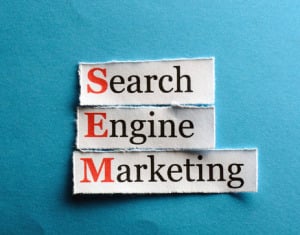Last Updated on October 23, 2017 by
SEO vs SEM: What’s the Difference?
Two seemingly similar references – SEO (Search Engine Optimization) and SEM (Search Engine Marketing) – are sometimes used so interchangeably, it’s understandable that many small business owners have been confused when comparing the two. And while they sound enough alike, SEO and SEM are actually different kinds of online marketing applications. Most small businesses know a thing or two about SEO in this day and age, as well as the different tactics used to help their website rank well in “organic” search results. But what about the somewhat lesser-known SEM? What makes it different from Search Engine Optimization protocols? Is one “better” than the other….and can both be implemented together in a marketing plan?
 What is SEM?
What is SEM?
Most business owners begin their marketing journey with a solidly-built website and invest in Search Engine Optimization tactics, yet most still don’t follow through with another very important component: Search Engine Marketing.
SEM is considered a broader-reaching approach than SEO, used to encompass different options available to tap into search engine technology including paid ads. SEM is often used to describe actions associated with positioning, submitting and researching a website within search engines; this includes Search Engine Optimization, paid listings and other search engine-related functions and services that can increase exposure and traffic to a website.
Further, SEM offers the opportunity to pay based on clicks – but you pay only for each click-through from the advertisement to your website. Ads in a successful SEM campaign are typically shown to those consumers looking specifically for your services or products, thus yielding a higher conversion rate.
 What is SEO?
What is SEO?
Search Engine Optimization – SEO – can be defined as strategies and tactics implemented to ensure that a site is accessible to a search engine (i.e. Google, Yahoo, etc.) while improving the chances that the site will be found by the search engine. The goal of a successful SEO campaign from a marketing standpoint is to obtain high-ranking placement in the search results page of a search engine, because Internet users often do not go through pages upon pages of search results – they normally look at the first few results found. So, it’s easy to understand that where your site ranks in a search is absolutely essential for directing more traffic toward your site.
Also vital to note is that the higher a website naturally ranks in organic results of a search, the greater the chance that the site will be visited by a user.
As experts in the art of Search Engine Optimization, we have often thought of SEO as a set of “white hat” best practices that web-masters and web content producers – like those on our team – follow to help them achieve a better ranking in search engine results for clients. Some of these practices include:
- Creating and publishing powerful site content
- Strategically using keywords and implementing keyword analysis
- Link building to improve link popularity
- Using social media links on sites such as Facebook and Twitter
- Improving a site’s navigation to provide a superior user experience
The Major Differences Between SEM and SEO
As we covered above, SEM is “broader” than SEO; where SEO aims to provide better organic search results, SEM utilizes the search engines to advertise a website or business to Internet consumers while sending a more targeted traffic flow to a website. Take, for example, a trendy fashionista who is using a search engine to look for “stylishly sexy stilettos;” in this case, the organic search engine results can assist a shoe manufacturer’s website in being more visible. The paid advertising, or sponsored links, are the kind prominently displayed beside or above the organic search results and are a product of SEM.
But let us be clear: SEO and SEM are not competing services. In fact, SEO is considered a subset of SEM services. If you want to conduct business on the Internet, you need to be visible in both organic and advertised links, which means you need both SEO and SEM implementations.
Using Both SEM and SEO in Marketing
Has it occurred to you yet? We’re living in a rapidly-changing, hyper-competitive world dominated by online marketing, one that has made it easy to get wrapped up in the last “miracle cure,” “shiny object” or “magic bullet” we think will remove all our marketing obstacles and deliver a flood of new customers to our virtual doorstep. But as the saying goes, “there’s no free lunch,” and in this case because we get so obsessed with seeking a single “one-size-fits-all” solution, we forget that we need to focus on developing a marketing strategy first. Plugging in the tools and tactics to make that strategy succeed can be worked on once this is achieved.
Because of this aforementioned obsession with finding a “magic bullet” common solution with regard to marketing, many people think of SEO and SEM as being mutually exclusive concepts – so they believe they should be focusing on one or the other. As professionals that handle SEO for a living, we can tell you that this approach is very short-sighted.
SEO and SEM: Complementary…Not Competitors
It’s important, first and foremost, not to think of SEO and SEM as competitors; rather, think of them as complementing each other. Done right, implementing a marketing strategy that uses both SEO and SEM together can create a synergy that skyrockets the amount of exposure for traffic to your website. As we so often tell our clients, think of SEO as your long-term “bedrock” traffic tool and SEM as a short-term, supplemental traffic tool with the potential for immediate return.
How does this apply? In our quest to drive traffic to websites in order to generate leads and, ultimately, sales, we need traffic now (in the short term) and on an ongoing regular basis (in the long-term). This is how SEO and SEM can be ideally used together. SEO can be very effective for driving traffic, but results don’t necessarily happen overnight; SEO takes an ongoing commitment to be considered successful, and it often takes several months or longer for SEO to generate significant levels of traffic.
Conversely, SEM can produce results almost immediately, and while it’s not free – it’s actually quite expensive depending on implementation – it can assist in driving large amounts of traffic to your site while you’re waiting for the results of your SEO campaign to kick in.
To get the maximum degree of traffic and exposure possible, we always recommend using SEO to gain traffic for your most vital keywords and SEM for your additional keywords, as opposed to using each for the exact same search terms.
 What is SEO?
What is SEO?